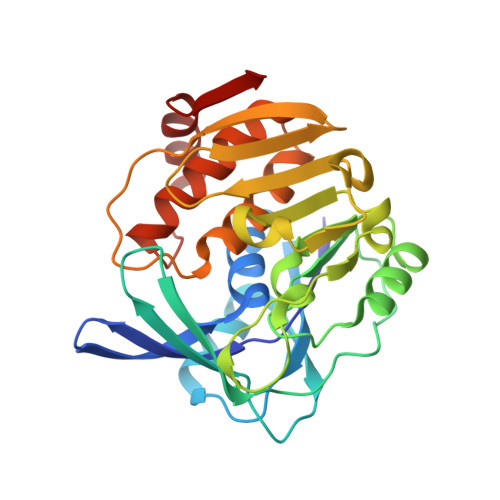Crystal Structure and Product Analysis of an Archaeal myo-Inositol Kinase Reveal Substrate Recognition Mode and 3-OH Phosphorylation
Nagata, R., Fujihashi, M., Sato, T., Atomi, H., Miki, K.(2015) Biochemistry 54: 3494-3503
- PubMed: 25972008
- DOI: https://doi.org/10.1021/acs.biochem.5b00296
- Primary Citation of Related Structures:
4XF6, 4XF7 - PubMed Abstract:
The TK2285 protein from Thermococcus kodakarensis was recently characterized as an enzyme catalyzing the phosphorylation of myo-inositol. Only two myo-inositol kinases have been identified so far, the TK2285 protein and Lpa3 from Zea mays, both of which belong to the ribokinase family. In either case, which of the six hydroxyl groups of myo-inositol is phosphorylated is still unknown. In addition, little is known about the myo-inositol binding mechanism of these enzymes. In this work, we determined two crystal structures: those of the TK2285 protein complexed with the substrates (ATP analogue and myo-inositol) or the reaction products formed by the enzyme. Analysis of the ternary substrates-complex structure and site-directed mutagenesis showed that five residues were involved in the interaction with myo-inositol. Structural comparison with other ribokinase family enzymes indicated that two of the five residues, Q136 and R140, are characteristic of myo-inositol kinase. The crystal structure of the ternary products-complex, which was prepared by incubating the TK2285 protein with myo-inositol and ATP, holds 1d-myo-inositol 3-phosphate (Ins(3)P) in the active site. NMR and HPLC analyses with a chiral column also indicated that the TK2285 reaction product was Ins(3)P. The results obtained here showed that the TK2285 protein specifically catalyzes the phosphorylation of the 3-OH of myo-inositol. We thus designated TK2285 as myo-inositol 3-kinase (MI3K). The precise identification of the reaction product should provide a sound basis to further explore inositol metabolism in Archaea.
Organizational Affiliation:
†Department of Chemistry, Graduate School of Science, Kyoto University, Sakyo-ku, Kyoto 606-8502, Japan.


















